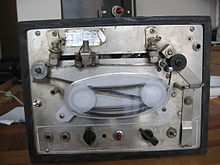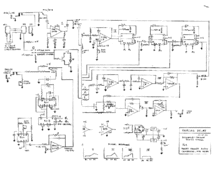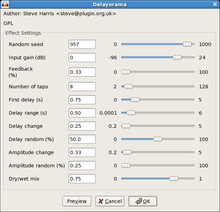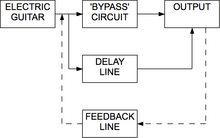Delay (audio effect)
Delayis anaudio signal processingtechnique that records an input signal to a storage medium and then plays it back after a period of time. When the delayed playback ismixedwith the live audio, it creates anecho-like effect, whereby the original audio is heard followed by the delayed audio. The delayed signal may be played back multiple times, or fed back into the recording, to create the sound of a repeating, decaying echo.[1]
Delay effects range from a subtle echo effect to a pronounced blending of previous sounds with new sounds. Delay effects can be created usingtape loops,an approach developed in the 1940s and 1950s and used by artists includingElvis PresleyandBuddy Holly.
Analog effects units were introduced in the 1970s; digital effects pedals in 1984; andaudio plug-insoftware in the 2000s.
History
[edit]The first delay effects were achieved usingtape loopsimprovised onreel-to-reel audio tape recordingsystems. By shortening or lengthening the loop of tape and adjusting theread-and-write heads,the nature of the delayed echo could be controlled. This technique was most common among early composers ofmusique concrètesuch asPierre Schaeffer,and composers such asKarlheinz Stockhausen,who had sometimes devised elaborate systems involving long tapes and multiple recorders and playback systems, collectively processing the input of a live performer or ensemble.[2]
American producerSam Phillipscreated aslapback echoeffect with twoAmpex350 tape recorders in 1954.[3][4]The effect was used by artists includingElvis Presley(such as on his track "Blue Moon of Kentucky") andBuddy Holly,[5]and became one of Phillips' signatures.[4]Guitarist and instrument designerLes Paulwas an early pioneer in delay devices.[6][7]According toSound on Sound,"The character and depth of sound that was produced from tape echo on these old records is extremely lush, warm and wide."[8]

Tape echoes became commercially available in the 1950s.[9]Tape echo machines contain loops of tape that pass over a record head and then a playback head. Anecho machineis the early name for a sound processing device used with electronic instruments to repeat the sound and produce a simulated echo. The time between echo repeats was adjusted by varying head position or tape speed. The length or intensity of the echo effect was adjusted by changing the amount of echo signal was fed back into the signal recorded to tape.[10]
A landmark device was theEchoSonicmade by AmericanRay Butts.It is a portable guitar amplifier with a built-in tape echo, which became used widely in country music (Chet Atkins) and especially in rock and roll (Scotty Moore).[11]
Dedicated machines for creating tape loops were introduced One example is theEchoplexwhich uses a tape loop. The length of delay is adjusted by changing the distance between the tape record and playback heads. Another is theAce ToneEC-1 Echo Chamber.[12]
With theRoland RE-201,introduced in 1973, Japanese engineerIkutaro Kakehashirefined the tape delay to make it more reliable and robust, with reduced tape wear and noise,wow,andflutter,additional controls, and additional tape heads. Different effects could be created by enabling different combinations of playback heads. By adjusting the controls and tape speed, musicians could createpitch-shiftingand oscillated effects. The RE-201 was used by acts includingBrian Setzer,Bob Marley,Portishead,andRadiohead.[6]
In the 1970s, Jamaicandub reggaeproducers used delay effects extensively;Lee Scratch Perrycreated "lo-fi sci-fi" effects by using delay andreverbon a mi xing consoletest toneanddub technoproducers such asBasic Channelintroduced delay toelectronic music.[13]Digital delay effects were developed with the arrival ofdigital recording.[5]
Analog delay
[edit]
Before the invention of audio delay technology, music employing an echo had to be recorded in a naturallyreverberantspace, often an inconvenience for musicians and engineers. The demand for an easy-to-use real-time echo effect led to the production of systems offering an all-in-oneeffects unitthat could be adjusted to produce echoes of any interval or amplitude. The presence of multipletaps(playback heads) made it possible to have delays at varying rhythmic intervals; this allowed musicians an additional means of expression over natural periodic echoes.
Tape delay
[edit]Early experiments such assend tape echo echo delay(STEED) atAbbey Road Studiosused standard and modifiedreel-to-reel tape recordersto produce delay.
Delay processors based on analog tape recording usemagnetic tapeas their recording and playback medium. Electric motors guide a tape loop through a device with a variety of mechanisms allowing modification of the effect's parameters.[14]Popular models include Ray Butts'EchoSonic(1952), theWatkins Copicat(1958),[15][16]theEchoplex(1959)[9]and theRoland Space Echo(1974).[17]
In the Echoplex EP-2, the play head position was fixed, while a combination record and erase head was mounted on a slide, thus the delay time of the echo was adjusted by changing the distance between the record and play heads.[citation needed]
The Space Echo uses a free-runningtape transportsystem to reduce tape wear, noise, andwow and flutter,and made the units more reliable and easy to transport.[18]It was more reliable and sturdy than previous tape echo devices, making it easy to travel and perform with.[18]It has been used by musicians in genres such asreggae,dub,trip hop,post-punkandexperimental rock.[18][19]
Thin magnetic tape was not entirely suited for continuous operation, however, so the tape loop has to be replaced from time to time to maintain theaudio fidelityof the processed sounds. TheBinson Echorecused a rotating magnetic drum or disc (not entirely unlike those used in modernhard-disk drives) as its storage medium. This provided an advantage over tape, as the durable drums were able to last for many years with little deterioration in the audio quality.[20]In later years, tape delay effects remained popular for the way the tape compresses and distorts, "creating the impression that the echoes are receding rather than just getting quieter".[21]
Oil can
[edit]An alternative echo system was the so-calledoil-can delaymethod, which uses electrostatic rather than electromagnetic recording.[22]
Invented byRay Lubow,the oil-can method uses a rotating disc of anodized aluminium coated with a suspension of carbon particles. An AC signal to a conductive neoprene wiper transfers the charge to the high impedance disc. As the particles pass by the wiper, they act as thousands of tiny capacitors, holding a small part of the charge. A second wiper reads this representation of the signal, and sends it to a voltage amplifier that mixes it with the original source. To protect the charge held by the particles and to lubricate the entire assembly, the disc runs inside a sealed can with enough of a specialinsulatingoil[a]to assure that an even coating is applied as it spins.[23][24]
The effect resembles an echo, but the whimsical nature of the storage medium causes variations in the sound that can be heard as a vibrato effect. Some early models featured control circuitry designed to feed the output of the read wiper to the write wiper, causing a reverberant effect as well.
Many different companies marketed these devices under various names. Fender sold the Dimension IV, the Variable Delay, the Echo-Reverb I, II, and III, and included an oil can in their Special Effects box. Gibson sold the GA-4RE from 1965–67. Ray Lubow himself sold many different versions under the Tel-Ray/Morley brand, starting out in the early sixties with the Ad-n-echo, and eventually producing the Echo-ver-brato, the Electrostatic Delay Line, and many others into the eighties.
Solid-state delay
[edit]
Thebucket-brigade devices(BBD) was developed at Philips in 1969. Delay effects utilizing this technology eventually became available. Notable examples include the Memory Man from Electro-Harmonix, released in 1976 and the Boss DM-2 released in 1981. BBD-based devices offered a convenient alternative to tape delays andleslie speakersbut were eventually largely supplanted by digital delays.[25]
Digital delay
[edit]
Digital delay systems function by sampling the input signal using ananalog-to-digital converter.The resulting digital audio is passed through amemory bufferand recalled from the buffer a short time later. Throughfeedbackof some of the delayed audio back into the buffer, multiple repeats of the audio are created.[26][b]The delayed (wet) output may be mixed with the unmodified (dry) signal after, or before, it is sent to adigital-to-analog converterfor output.
Digital delay effects were initially available as expensive rack-mounted units intended for use in television and audio production studios. One of the first was theEventideDDL 1745 from 1971.[27]Another popular rack-mount digital delay was theAMSDMX 15-80 of 1978.[28]As digital memory became cheaper in the 1980s, units likeLexiconPCM42,RolandSDE-3000,TC Electronic2290 offered more than three seconds of delay time, enough to create background loops, rhythms, and phrases. The 2290 was upgradeable to 32 seconds andElectro-Harmonixoffered a 16-second delay and looping machine. Eventually, as costs came down further and the electronics grew smaller, they became available in the form of foot pedals. The first digital delay offered in a pedal was theBossDD-2 in 1984. Rack-mounted delay units evolved into digital reverb units and on to digital multi-effects units capable of more sophisticated effects than pure delay, such as reverb andaudio time stretching and pitch scalingeffects.
Digital delays present an extensive array of options, including control over the time before playback of the delayed signal. Most also allow the user to select the overall level of the processed signal in relation to the unmodified one, or the level at which the delayed signal is fed back into the memory, to be repeated again. Some systems allow more exotic controls, such as the ability to add anaudio filterand modulate the playback rate.
Looping
[edit]
While the early delay units with a long delay capacity could be used to record arifforchord progressionand then play over it, they were challenging to work with. The Paradis Loop Delay,[29]created in 1992, was the first unit with dedicated looping functions such as record, overdub, multiply, insert, and replace, which made it more intuitive and user-friendly.Gibsonmanufactured a slightly improved version as the Echoplex Digital Pro[30]until 2006.
Computer software
[edit]
A natural development from digital delay-processing hardware was the appearance ofsoftware-based delay systems. In large part, this coincided with the popularity of audio editing software. Software delays, in many cases, offer much greater flexibility than even the most recent digital hardware delays. Software implementations may offer shifting or random delay times, or the insertion of other audio effects in the feedback path. Manysoftware pluginshave added functionality to emulate the sounds of the earlier analog units. Abundantmain memoryon modern personal computers offers ample delay time.
Artistic uses
[edit]In popular and electronic music, electric guitarists use delay to produce densely overlaid textures of notes with rhythms complementary to the music.U2guitaristthe Edgeuses delay while he plays arpeggios on electric guitar, thus creating a sustained, synth pad-like background.[31]Vocalists and instrumentalists use delay to add a dense or ethereal quality to their singing or playing. Extremely long delays of 10 seconds or more are often used to create loops of a whole musical phrase.Robert Frippused twoRevoxreel-to-reel tape recorders to achieve very long delay times for solo guitar performance. He dubbed this technology "Frippertronics",and used it in a number of recordings.[32]
John Martynwas a pioneer of the echoplex. Perhaps the earliest indication of his use can be heard on the songs "Would You Believe Me" and "The Ocean" on the albumStormbringer!released in February 1970.
Function
[edit]
Delay effects add a time delay to anaudio signal.Blending the delayed audio with the original audio creates anecho-like effect, whereby the original audio is heard followed by the delayed audio.[5]The delayed signal may be treated separately from the input audio - for example, with anequalizer.[34]
Most delay effects allow users to set the delay time, or the amount of time between each audio playback. The may be synchronized to aBPM,allowing users to set time values asbeat divisions.Delay is used to create other effects, including reverb,chorus,andflanging.[5]
Delay effects typically allow users to add and adjustfeedback.By feeding some of the delayed audio back into the delay mechanism, multiple repeats of the audio are heard. At low feedback settings, each repeat fades in volume. High levels of feedback can cause the level of the output to rapidly increase, becoming louder and louder; this may be managed using alimiter.
Haas effect
[edit]Short delays (50 ms or less) create a sense ofbroadeningthe sound without creating a perceptible echo and can be used to addstereo widthor simulatedouble-tracking(layering two performances).[34]The effect is known as theprecedence effector Haas effect, after the German scientist Helmut Haas.[34]
Ping-pong delay
[edit]In a ping-pong delay, the delayed signal alternates between the two channels of astereoprogram.[34]
Multi-tap
[edit]In a multi-tap delay, multipletaps(outputs) are taken from a delay buffer, each with independent times and levels, and summed with the original signal.[5][34]Multi-tap delays can be used to create rhythmic patterns or dense,reverb-like effects.[34]
Doubling echo
[edit]Doubling echois produced by adding short delay to a recorded sound. Delays of thirty to fifty milliseconds are the most common; longer delay times becomeslapback echo.Mi xing the original and delayed sounds creates an effect similar todoubletracking,orunisonperformance.
Slapback echo
[edit]Slapback echouses a delay time of 60 to 250 milliseconds with little or no feedback.[c]A slapback delay creates athickeningeffect. The effect is characteristic of vocals on 1950srock-n-rollrecords. In July 1954,Sam Phillipsproduced the first of five 78s and 45s thatElvis Presleywould release onSun Recordsover the next year and a half, all of which featured a novel production technique that Phillips termedslapback echo.[35]The effect was produced by re-feeding the output signal from the playback head tape recorder to its record head. The physical space between heads, the speed of the tape, and the chosen volume being the main controlling factors. Analog and later digital delay machines also easily produced the effect. It is also sometimes used on instruments, particularlydrumsandpercussion.
Flanging, chorus effect, and reverb
[edit]Flanging,chorusandreverbare all delay-based sound effects. With flanging and chorus, the delay time is very short and usually modulated.[36]With reverberation, there are multiple delays and feedback so that individual echoes are blurred together, recreating the sound of anacoustic space.
Straight delay
[edit]Straight delayis used insound reinforcement systemsto compensate for thepropagation of soundthrough the air.[37]Unlike audio delay effects devices, straight delay is not mixed back in with the original signal. The delayed signal alone is sent to loudspeakers so that the speakers distant from the stage will reinforce the stage sound at the same time or slightly later than the acoustic sound from the stage. The delayed signal uses approximately 1 millisecond of straight delay per foot of air or 3 milliseconds per meter.[d]Because of theHaas effect,this technique allows audio engineers to use additional speaker systems placed away from the stage and still give theillusionthat all sound originates from the stage. The purpose is to deliver sufficient sound volume to the back of the venue without resorting to excessive sound volumes near the front.[38]
Straight delay is also used inaudio to video synchronizationto align sound with visual media (e.g., on TV or web broadcasting), if the visual source is delayed. Visual media can become delayed by a number of mechanisms or reasons such astime base correction,video scalingandframebuffers,in which case the associated audio must be delayed to match the visual content.
Samples
[edit]See also
[edit]- Analog delay line
- Broadcast delay– The practice of intentionally delaying a live broadcast
- Digital delay line
Notes
[edit]- ^Union Carbide UCON lb65[22]
- ^High levels of feedback can cause the level of the output to rapidly increase (self-oscillation), becoming louder and louder; this may be managed withlimiters.
- ^Increasing the feedback of a slapback effect can create a sound similar to aspring reverbeffect.[34]
- ^Depending on the air temperature's effect on thespeed of sound.At an air temperature of 20 °C (68 °F), one meter of sound travel takes 2.92 milliseconds, and one foot of sound travel takes 0.888 ms.
References
[edit]- ^Lehman, Scott (1996)."Effects Explained: Delay".Archived from the original on 2003-04-02.
{{cite web}}:CS1 maint: unfit URL (link) - ^Gehlaar, Rolf (1998),Leap of Faith: A Personal Biography of Karlheinz Stockhausen's Prozession
- ^"Sam Phillips: Sun Records".Sound on Sound.Archivedfrom the original on 2018-01-29.Retrieved2021-06-12.
- ^abBlitz, Matt (2016-08-15)."How Sam Phillips invented the sound of rock and roll".Popular Mechanics.Archivedfrom the original on 2016-08-18.Retrieved2021-06-12.
- ^abcde"The ultimate guide to effects: delay".MusicRadar.7 June 2011.Archivedfrom the original on 2015-09-08.Retrieved2021-06-12.
- ^abDregni, Michael."The Roland Space Echo".Vintage Guitar.Archived fromthe originalon 2015-09-05.Retrieved2021-06-13.
- ^Meeker, Ward."Les Paul Remembered".Vintage Guitar.Archivedfrom the original on 2014-09-10.Retrieved2021-06-13.
- ^Haas, Will (August 2007)."Tape delay in your DAW".Sound on Sound.Archivedfrom the original on 2017-05-12.Retrieved2021-06-12.
- ^abDregni, Michael (July 2012). "Echoplex EP-2".Vintage Guitar.pp. 54–56.
- ^Milano, Dominic (1988).Multi-Track Recording.Hal Leonard. p. 37.ISBN978-0-88188-552-1.
- ^Hunter, Dave (April 2012). "The Ray Butts EchoSonic".Vintage Guitar.pp. 46–48.
- ^Ace Tone Catalog 1969(PDF),Sorkin/Ace Tone, 1969, p. 16, archived fromthe original(PDF)on 2014-05-12
- ^"Creating dub delays with standard plugins".Attack Magazine.2020-08-20.Archivedfrom the original on 2020-10-22.Retrieved2021-06-13.
- ^"RE-201 Space Echo",Vintage Synth Explorer.1997.Retrieved on July 30, 2006.
- ^"NAMM Oral History Interviews: Charles Watkins".NAMM.org.NAMM. 16 May 2008.Retrieved31 January2022.
- ^Inglis, Sam (February 2021)."Wavesfactory Echo Cat".soundonsound.SOS Publications Group.Retrieved31 January2022.
- ^Dregni, Michael (December 2014)."The Roland Space Echo".Vintage Guitar.Archived fromthe originalon 2015-09-05.Retrieved2021-06-13.
- ^abcDregni, Michael (December 2014)."The Roland Space Echo".Vintage Guitar.Archived fromthe originalon 2015-09-05.Retrieved2021-06-13.
- ^Brakes, Rod (2022-03-24)."Boss Enters a New Age of Space Echo with the RE-2 and RE-202".Guitar Player.Retrieved2023-04-02.
- ^Studholme, Richard."A brief History".Archived from the original on 2007-10-20.
{{cite web}}:CS1 maint: unfit URL (link) - ^White, Paul (October 2007)."Boss RE20".Sound on Sound.SOS Publications Group.Retrieved2023-04-02.
- ^ab Scott (2007-08-11)."Oil Can Delays".Retrieved2018-08-04.
- ^US 2892898,Raymond Lubow, "Delay apparatus"
- ^R.G. Keen."The Technology of Oil Can Delays".Retrieved2021-02-15.
- ^"A brief history of bucket-brigade delays".Retrieved2022-10-17.
- ^Smith, Geoff (May 2012)."Creating and using custom delay effects".Sound on Sound.Archivedfrom the original on 2016-06-28.Retrieved2021-06-13.
- ^"50th Flashback #2.1: The DDL Digital Delay".Retrieved2021-05-13.
- ^"AMS DMX 15-80s Stereo Digital Delay".Retrieved2019-06-26.
- ^"Paradis Loop Delay".Loopers-Delight.
- ^Matthias Grob."How the Gibson / Oberheim Echoplex Came Together".Loopers-Delight.
- ^The Edge,Davis Guggenheim(director) (2008).It Might Get Loud(film).Sony Pictures Classics.
- ^"Frippertronics: how Robert Fripp and Brian Eno brought looping to life".Happy Mag.2022-08-06.Retrieved2022-09-09.
- ^Hodgson, Jay (2010).Understanding Records.p. 124.ISBN978-1-4411-5607-5.
- ^abcdefgSmith, Geoff (May 2012)."Creating and using custom delay effects".Sound on Sound.Archivedfrom the original on 2016-06-28.Retrieved2021-06-13.
- ^Rob Bowman. "Phillips, Sam." Grove Music Online. Oxford Music Online. Oxford University Press. Web. 20 Jul. 2016.
- ^Reid, Gordon (June 2004)."More Creative Synthesis With Delays".Sound on Sound.
- ^Mike Sokol (January 8, 2018)."Why Wait? The Where, How & Why Of Delay Loudspeakers".Retrieved2024-03-08.
- ^"Speaker Delay: What You Need to Know".Gearsupply. April 30, 2021.Retrieved2024-03-08.


